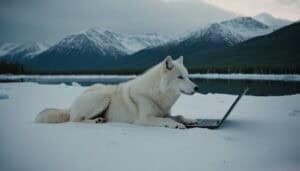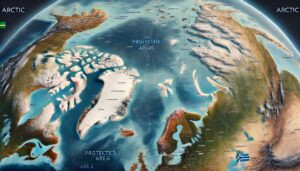Introduction
Understanding Arctic wolves, their habitat, and conservation efforts are essential for students learning about wildlife and environmental science
This article provides a comprehensive guide to the best educational resources available for teaching about Arctic wolves. We will explore online and multimedia resources, books and lesson plans, educational games, classroom activities, scientific articles, conservation projects, and virtual tours
These resources will help educators create engaging and informative lessons that inspire students to learn more about Arctic wolves and their environment
Online and Multimedia Resources
Effective educational resources for teaching about Arctic wolves can greatly enhance student engagement and understanding
The internet provides a wealth of information, including websites, interactive learning platforms, multimedia tools, and notable documentaries. This section will explore these resources in detail
Top Websites
Several websites offer comprehensive information about Arctic wolves, tailored for educational purposes:
National Geographic Kids: This site provides a kid-friendly overview of Arctic wolves, including their habitat, diet, and behavior. The information is presented in an engaging way, with plenty of images and videos to capture students’ attention
World Wildlife Fund (WWF): The WWF’s website includes detailed sections on Arctic wolves, their role in the ecosystem, and conservation efforts. This resource is particularly useful for older students who are looking to understand the broader environmental impact of Arctic wolves
Defenders of Wildlife: This organization’s website offers extensive resources on Arctic wolves, including fact sheets, educational videos, and conservation updates. The site also features ways to get involved in conservation efforts, making it a great tool for teachers looking to incorporate activism into their lessons
Interactive Learning Platforms
Interactive learning platforms can make the study of Arctic wolves more engaging through the use of simulations, games, and interactive modules:
PBS LearningMedia: This platform offers interactive lessons and videos on Arctic wolves and other wildlife. The content is designed to align with educational standards, making it easy for teachers to integrate into their existing curriculum
ARKive: Though no longer updated, ARKive remains a valuable repository of wildlife videos and photos, including a significant section on Arctic wolves. The interactive features allow students to explore different aspects of the wolves’ lives and habitats
Khan Academy: While primarily known for its math and science courses, Khan Academy offers environmental science modules that include sections on Arctic ecosystems. Interactive quizzes and activities help reinforce the material covered in the lessons
Multimedia Tools
Multimedia tools can provide a rich, visual learning experience that helps students better understand and retain information about Arctic wolves:
YouTube: Channels like BBC Earth and National Geographic have high-quality documentaries and short videos on Arctic wolves. These videos can be used to supplement lessons and provide students with a visual understanding of the topics being discussed
Google Earth: This tool allows students to explore the Arctic region virtually, helping them to understand the geography and environmental conditions that Arctic wolves inhabit. Teachers can create guided tours that highlight key locations related to Arctic wolves
Virtual Reality (VR) Experiences: VR platforms like Oculus and Google Expeditions offer immersive experiences where students can virtually observe Arctic wolves in their natural habitat. These tools can be particularly engaging for students and provide a sense of presence that traditional resources cannot
Notable Documentaries
Documentaries can provide in-depth insights into the life and behavior of Arctic wolves, making them a valuable resource for both teachers and students:
“The Arctic Wolf: Living with the Pack”: This documentary by PBS offers an intimate look at the life of Arctic wolves, following a pack in the wild. It covers their hunting strategies, social structures, and the challenges they face in a changing environment
“White Wolf”: Produced by BBC Earth, this documentary explores the life of a lone Arctic wolf in the harsh Arctic landscape. It provides a dramatic and engaging narrative that can captivate students and encourage further interest in wildlife conservation
“Arctic Wolves: Ghosts of the Tundra”: Available on various streaming platforms, this documentary offers stunning visuals and detailed information about the survival strategies of Arctic wolves. It also highlights the impact of climate change on their habitat
By incorporating these online and multimedia resources into their lessons, educators can create a dynamic and engaging learning experience that helps students understand the importance of Arctic wolves and the ecosystems they inhabit. These tools not only provide factual information but also foster a deeper appreciation for wildlife and conservation efforts
Books and Lesson Plans
Books and lesson plans are essential educational resources that provide structured information and activities to enhance students’ understanding of Arctic wolves. These resources can be integrated into various subjects, such as science, geography, and environmental studies, making them versatile tools for educators
Recommended Books
Books offer in-depth information and can be used for independent reading or classroom instruction. Here are some highly recommended books on Arctic wolves:
“Arctic Wolf: The High Arctic” by L. David Mech: This book is written by a renowned wolf biologist and offers detailed insights into the life of Arctic wolves. It is suitable for middle to high school students and provides scientific data alongside engaging narratives
“The Wolves of the Beyond” series by Kathryn Lasky: This fictional series is aimed at younger readers and introduces them to the concept of Arctic wolves through the adventures of a wolf pup. While it is a fictional account, it incorporates factual information about wolf behavior and habitat
“Arctic Animals: A Children’s Guide to the Arctic Wolf and Other Arctic Wildlife” by Dakota Daniels: This book is designed for elementary school students and offers simple explanations, beautiful illustrations, and fun facts about Arctic wolves and other Arctic animals
Comprehensive Lesson Plans
Lesson plans provide a structured approach to teaching about Arctic wolves, with specific objectives, activities, and assessments. Here are some excellent sources for comprehensive lesson plans:
Teachers Pay Teachers: This platform offers a variety of lesson plans created by educators for different grade levels. You can find complete units on Arctic wolves, including worksheets, activities, and assessments
National Geographic Education: National Geographic offers lesson plans that include multimedia resources, interactive activities, and detailed instructions for teaching about Arctic wolves. These lesson plans are aligned with educational standards and can be easily integrated into existing curricula
WWF Wild Classroom: The World Wildlife Fund’s Wild Classroom provides free, downloadable lesson plans focused on Arctic wolves and their conservation. These plans include hands-on activities, discussion questions, and project ideas to engage students in learning about wildlife and the environment
Age-Appropriate Resources
When teaching about Arctic wolves, it is crucial to use age-appropriate resources to ensure that the content is accessible and engaging for students. Here are some recommendations for different age groups:
Elementary School:
Books: “Arctic Animals: A Children’s Guide to the Arctic Wolf” by Dakota Daniels
Activities: Simple crafts, coloring pages, and basic fact sheets about Arctic wolves
Middle School:
Books: “Arctic Wolf: The High Arctic” by L. David Mech
Activities: Research projects, interactive websites, and multimedia presentations on Arctic wolves
High School:
Books: “Arctic Wolf: The High Arctic” by L. David Mech
Activities: In-depth research projects, scientific article reviews, and discussions on conservation issues related to Arctic wolves
By incorporating these books and lesson plans into the curriculum, educators can provide students with a well-rounded understanding of Arctic wolves. These resources cater to various learning styles and age groups, ensuring that all students can engage with the material effectively
Educational Games and Classroom Activities
Educational games and classroom activities offer interactive and engaging ways for students to learn about Arctic wolves. These resources can make learning more dynamic, encouraging students to actively participate and retain information more effectively
Engaging Educational Games
Games are an excellent way to teach students about Arctic wolves in a fun and interactive manner. Here are some recommended educational games:
“WolfQuest“: This game simulates the life of a wolf in Yellowstone National Park, but it also includes modules on Arctic wolves. Players can learn about wolf behavior, hunting techniques, and pack dynamics while navigating various challenges in the wild
“Eco“: In this environmental simulation game, players work together to build a civilization in harmony with nature. It includes modules on Arctic ecosystems and wildlife, including Arctic wolves, helping students understand the impact of human activities on the environment
“National Geographic Kids: Animal Jam“: This online game allows students to explore different ecosystems, including the Arctic. Players can learn about Arctic wolves and other wildlife through interactive quests and activities
Classroom Activities
Classroom activities provide hands-on learning experiences that can enhance students’ understanding of Arctic wolves. Here are some ideas for engaging classroom activities:
Habitat Dioramas: Students can create dioramas of the Arctic tundra, including Arctic wolves and other wildlife. This activity helps students understand the environment in which Arctic wolves live and the challenges they face
Role-Playing Scenarios: Organize role-playing activities where students act out different roles within an Arctic wolf pack, such as the alpha, beta, and omega wolves. This can help students learn about wolf pack dynamics and social structures
Conservation Projects: Encourage students to develop and present conservation projects focused on Arctic wolves. They can research current threats to Arctic wolves, propose solutions, and create presentations to share with the class
Incorporating Conservation in Curriculum
Teaching students about conservation is crucial for fostering an understanding of the importance of protecting Arctic wolves and their habitat. Here are some ways to incorporate conservation into the curriculum:
Guest Speakers: Invite wildlife conservationists or researchers to speak to the class about their work with Arctic wolves. This provides students with firsthand insights into conservation efforts and the challenges faced by these animals
Field Trips: Organize field trips to local wildlife reserves, zoos, or nature centers that have Arctic wolf exhibits. These trips can provide students with a closer look at Arctic wolves and the efforts being made to protect them
Service Learning Projects: Engage students in service learning projects that support Arctic wolf conservation. This could include fundraising for conservation organizations, creating awareness campaigns, or participating in citizen science projects that monitor wildlife populations
By incorporating educational games and classroom activities into their lessons, educators can create a more interactive and engaging learning environment. These resources help students understand the complexities of Arctic wolf behavior and conservation in a fun and meaningful way
Scientific Articles and Conservation Projects
Understanding Arctic wolves involves not only engaging multimedia resources and activities but also delving into scientific research and participating in conservation efforts. This section will cover key scientific articles and ways for students to get involved in conservation projects
Key Scientific Articles
Scientific articles provide in-depth, peer-reviewed research that can deepen students’ understanding of Arctic wolves. Here are some notable articles:
“The Ecology of the Arctic Wolf” by L. David Mech (2012): This seminal paper explores the ecology, behavior, and social structure of Arctic wolves based on decades of research. It is essential reading for students interested in the scientific study of these animals
“Climate Change and the Future of Arctic Wolves” by James A. Estes and colleagues (2017): This article examines the impacts of climate change on Arctic wolf populations and their habitat. It discusses the potential challenges and adaptations these wolves may face as their environment changes
“Diet and Predatory Behavior of Arctic Wolves” by Rolf O. Peterson (2015): This research paper provides detailed information on the dietary habits and hunting strategies of Arctic wolves, highlighting how they survive in the harsh Arctic environment
Student Involvement in Conservation
Involving students in conservation projects can foster a deeper appreciation for Arctic wolves and inspire them to take action. Here are some ways students can participate:
Adopt a Wolf Program: Many organizations, such as the World Wildlife Fund (WWF) and Defenders of Wildlife, offer adoption programs where students can symbolically adopt an Arctic wolf. This can raise funds for conservation efforts and increase awareness among students
Citizen Science Projects: Encourage students to participate in citizen science projects that monitor wildlife populations. Websites like Zooniverse offer opportunities for students to contribute to real scientific research by analyzing data and reporting sightings
School-Based Conservation Clubs: Start a conservation club at school where students can engage in activities like fundraising for conservation organizations, organizing awareness campaigns, and participating in local environmental clean-up efforts
Conservation Campaigns: Have students design and implement their own conservation campaigns. They can create posters, social media content, and presentations to educate their peers and the community about the importance of protecting Arctic wolves
Collaborating with Conservation Organizations
Collaboration with established conservation organizations can provide students with additional resources and expertise. Here are some organizations that focus on Arctic wolf conservation:
World Wildlife Fund (WWF): The WWF works globally to protect Arctic wolves and their habitat. They offer educational resources, volunteer opportunities, and ways to get involved in conservation efforts
Defenders of Wildlife: This organization focuses on the protection of all wildlife, including Arctic wolves. They provide resources for educators, as well as opportunities for students to engage in advocacy and conservation projects
International Wolf Center: The International Wolf Center offers a wealth of educational materials on wolves, including Arctic wolves. They provide webinars, virtual field trips, and resources for teachers and students
By exploring scientific articles and participating in conservation projects, students can gain a comprehensive understanding of Arctic wolves and the efforts needed to protect them. These activities not only enhance their knowledge but also empower them to contribute to conservation initiatives
Virtual Tours and Field Trips
Virtual tours and field trips offer unique opportunities for students to explore the habitats of Arctic wolves without leaving the classroom. These experiences can provide immersive learning that complements traditional educational resources
Available Virtual Tours
Several organizations and platforms offer virtual tours focused on Arctic wolves and their natural habitats
Here are some noteworthy options:
Explore.org: This platform provides live streaming of various wildlife habitats, including those of Arctic wolves. Students can watch real-time footage of wolves in their natural environment, which can be both educational and captivating
National Geographic Virtual Field Trips: National Geographic offers virtual field trips that take students to different parts of the world, including the Arctic. These trips include videos, interactive maps, and educational activities related to Arctic wildlife, including wolves
Google Expeditions: Google Expeditions provides virtual reality (VR) experiences that allow students to explore the Arctic tundra and observe Arctic wolves in a 360-degree environment. This immersive experience can help students feel like they are actually in the Arctic
Benefits of Virtual Field Trips
Virtual field trips offer several advantages over traditional field trips, especially when it comes to studying remote areas like the Arctic
Here are some benefits:
Accessibility: Virtual field trips can be accessed from anywhere with an internet connection, making them available to all students regardless of location or financial constraints
Safety: Exploring the Arctic can be dangerous due to its harsh weather conditions. Virtual trips eliminate these risks while still providing an in-depth learning experience
Interactivity: Many virtual field trips offer interactive elements, such as quizzes, polls, and virtual guides, that can enhance student engagement and retention of information
Cost-Effective: Traditional field trips can be expensive, requiring transportation, accommodations, and other logistical arrangements. Virtual trips are typically much cheaper, often only requiring a subscription or a one-time fee
How to Organize Virtual Field Trips
Organizing a virtual field trip requires careful planning to ensure it is educational and engaging for students
Here are some steps to help you organize a successful virtual field trip:
Choose a Platform: Select a reliable platform that offers high-quality virtual tours of the Arctic and Arctic wolves. Ensure that the platform provides educational content that aligns with your curriculum goals
Prepare Students: Introduce the topic beforehand and provide students with background information about Arctic wolves and their habitat. This will help them understand and appreciate the virtual trip
Create an Itinerary: Plan the virtual trip as you would a physical trip. Outline the different sections or stops of the virtual tour and what students can expect to learn at each point
Interactive Elements: Incorporate interactive elements such as quizzes, discussion questions, and hands-on activities related to the virtual tour. This can help maintain student engagement and reinforce learning
Follow-Up Activities: Plan follow-up activities to extend learning beyond the virtual trip. These can include writing assignments, group projects, or presentations based on what students learned during the virtual tour
Feedback and Reflection: After the virtual field trip, ask students to provide feedback and reflect on their experience. This can help you improve future virtual trips and understand what students found most valuable
By utilizing virtual tours and field trips, educators can provide students with an immersive and interactive way to learn about Arctic wolves. These experiences can make the study of Arctic wildlife more accessible and engaging, fostering a deeper understanding and appreciation for these magnificent creatures
Conclusion
Teaching about Arctic wolves can be significantly enhanced through a variety of educational resources
By leveraging online and multimedia tools, books and lesson plans, educational games and classroom activities, scientific articles and conservation projects, and virtual tours and field trips, educators can create a comprehensive and engaging learning experience for students
Online and Multimedia Resources provide accessible, interactive, and visually stimulating content that can capture students’ interest and cater to different learning styles. Websites like National Geographic Kids and WWF, interactive platforms like PBS LearningMedia, and multimedia tools like YouTube and Google Earth offer valuable information and immersive experiences
Books and Lesson Plans serve as foundational educational tools that offer structured and in-depth information on Arctic wolves
Recommended books such as “Arctic Wolf: The High Arctic” by L. David Mech and the “Wolves of the Beyond” series by Kathryn Lasky, along with comprehensive lesson plans from Teachers Pay Teachers and National Geographic Education, ensure that content is tailored to various age groups and educational standards
Educational Games and Classroom Activities make learning about Arctic wolves interactive and enjoyable. Games like “WolfQuest” and “Eco,” along with hands-on activities like habitat dioramas and role-playing scenarios, engage students actively and enhance their understanding of wolf behavior and conservation
Scientific Articles and Conservation Projects provide students with a deeper understanding of Arctic wolves through peer-reviewed research and active participation in conservation efforts
Key scientific articles by researchers such as L. David Mech and James A. Estes, along with opportunities for student involvement in programs like the WWF’s Adopt a Wolf, empower students to contribute to real-world conservation initiatives
Virtual Tours and Field Trips offer unique and immersive ways to explore the Arctic environment and observe Arctic wolves. Platforms like Explore.org, National Geographic Virtual Field Trips, and Google Expeditions allow students to experience the Arctic remotely, making learning both accessible and engaging
By integrating these resources into their teaching strategies, educators can inspire students to develop a comprehensive understanding of Arctic wolves, their ecological significance, and the importance of conservation efforts
These diverse tools and activities not only provide factual knowledge but also foster a deeper appreciation for wildlife and the environment, encouraging the next generation to become informed and active stewards of the natural world










